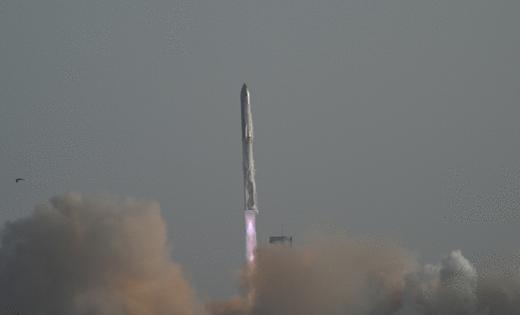FAA closes latest SpaceX investigations, opens door for next Starship launch
Published in News & Features
ORLANDO , Fla. — SpaceX has had a tough year with its Starship program, but the Federal Aviation Administration has cleared the path for the next-generation rocket’s 10th suborbital launch attempt as early as next weekend.
The FAA on Friday closed investigations into mishaps suffered on the ninth launch in May that saw the Super Heavy booster, the first ever flown for a second time, get destroyed on its reentry attempt while the upper stage was lost over the Indian Ocean.
“There are no reports of public injury or damage to public property. The FAA oversaw and accepted the findings of the SpaceX-led investigation,” reads a statement from the FAA. “The final mishap report cites the probable root cause for the loss of the Starship vehicle as a failure of a fuel component. SpaceX identified corrective actions to prevent a reoccurrence of the event.”
The loss of the upper stage before its planned landing attempt marked the third flight-related mission failure for Starship in 2025 after launches in January and March ended with the upper stage exploding and lighting up the skies across South Florida, the Bahamas and Caribbean. The company also lost a Starship upper stage during a static fire test that destroyed one of its test stands.
Despite the setbacks, and with the FAA’s clearance, SpaceX has slated Starship Flight 10 for as early as Aug. 24 launching from its test site Starbase in Texas during a window that runs from 7:30-8:30 p.m.
The company on Friday detailed its findings for the Flight 9 issues as well as the test pad explosion on its website.
The angle with which the Super Heavy booster came back in for a landing was more severe than previous landing attempts. Because it was the first reuse of the booster, SpaceX opted to not try and recapture it like it had on two previous Starship flights using its “chopsticks” feature on the launch tower. Instead, it broke up during an “energetic event” at an altitude of about 3,200 feet.
SpaceX put said the debris had no obvious detrimental effect on marine life.
“SpaceX works with an experienced global response provider to retrieve any debris that may wash up in South Texas and/or Mexico as a result of Starship flight test operations,” the company stated. “During the survey of the expected debris field from the booster, there was no evidence of any floating or deceased marine life that would signal booster debris impact harmed animals in the vicinity.”
SpaceX stated it would change the angle on return flights to put less pressure on the booster.
For the upper stage, video evidence pointed to the failure in the spacecraft’s nosecone area of a fuel diffuser canister that caused it to fill with liquid methane that ended up setting off a domino effect that had it automatically dumping fuel in space for a safer return over the designated entry area of the Indian Ocean about 46 minutes after launch.
“To address the issue on upcoming flights, the fuel diffuser has been redesigned to better direct pressurized gas into the main fuel tank and substantially decrease the strain on the diffuser structure,” SpaceX posted. “The new design underwent a more rigorous qualification campaign, subjecting it to flight-like stresses and running for more than ten times the expected service life with no damage.”
For Flight 10, SpaceX plans to fly the Super Heavy booster with more landing burn tests, meaning once again there will be no attempt for a tower recovery, but instead aim for an offshore landing spot in the Gulf.
For the upper stage, SpaceX will try again to perform its first payload deployment during a suborbital flight that will aim again for reentry in the Indian Ocean off the western coast of Australia. The flight will also attempt a relight of one of its six Raptor engines while in space.
“The flight test includes several experiments focused on enabling Starship’s upper stage to return to the launch site,” SpaceX stated. “A significant number of tiles have been removed from Starship to stress-test vulnerable areas across the vehicle during reentry.”
The reentry is still designed to test the upper stage’s structural limits, so it could still suffer some sort of demise before reentering.
“Flight tests continue to provide valuable learnings to inform the design of the next generation Starship and Super Heavy vehicles,” SpaceX stated. “With production ramping up inside Starfactory at Starbase alongside new launch and test infrastructure actively being built in Texas and Florida, Starship is poised to continue iterating towards a rapidly and fully reusable launch system.”
To date all launches have been from Texas, but the company is building out two launch sites on the Space Coast.
At more than 400 feet tall and with the booster producing more than 16 million pounds of thrust at liftoff, Starship is the biggest and most powerful rocket that has made it to space, although it has yet to perform an orbital launch.
NASA has a vested interest in the system getting completed, as a version of Starship has been tapped to be the human landing system for the Artemis III mission that seeks to return humans to the moon for the first time since the end of the Apollo program in 1972.
Despite the partial failure of Flight 9, the FAA this year increased SpaceX’s license so it can fly up to 25 missions a year out of Texas.
_______
©2025 Orlando Sentinel. Visit orlandosentinel.com. Distributed by Tribune Content Agency, LLC.







Comments